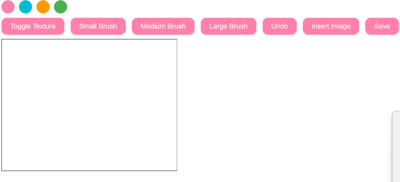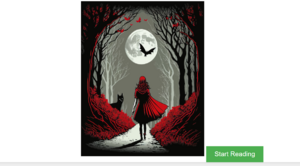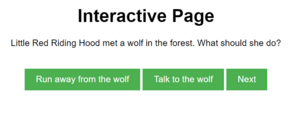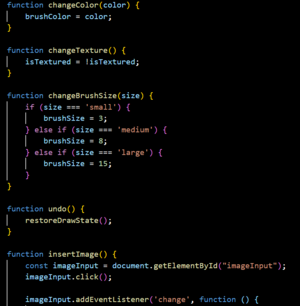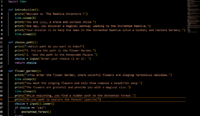User:Suzan/Proposalirmak: Difference between revisions
(→HOW?) |
(→HOW?) |
||
| Line 10: | Line 10: | ||
== HOW? == | == HOW? == | ||
[[File:Screenshot 2023-11-26 224931.png|thumb|Interactive story rapid prototype with little red riding hood]] | [[File:Screenshot 2023-11-26 224931.png|thumb|Interactive story rapid prototype with little red riding hood]] | ||
The path to making Wink begin from reading articles on interactivity and child-computer interaction. The first two months were spent going through readings, finding a suitable age gap for the desired interaction and making rapid prototoypes for interactive content. Wink will need a specific design to make the platform user friendly and easier for children to navigate. | The path to making Wink begin from reading articles on interactivity and child-computer interaction. The first two months were spent going through readings, finding a suitable age gap for the desired interaction and making rapid prototoypes for interactive content. Wink will need a specific design to make the platform user friendly and easier for children to navigate. I will design prototypes of an interface where children can easily navigate through reading and making. Following this, I will add the interactive stories, drawing pad and tools to be used in making section to be tried out in an interactive school in Rotterdam which I contacted. will be tried out. with the feedback gained from this workshop, I will revisit the prototype and proof it and make final touches for Wink. | ||
[[File:Screenshot 2023-10-18 150822.png|left|thumb|400x400px|drawing pad rapid prototype ]] | [[File:Screenshot 2023-10-18 150822.png|left|thumb|400x400px|drawing pad rapid prototype ]] | ||
[[File:Screenshot 2023-11-26 224950.png|thumb|interactive story rapid prototype with little red riding hood|left]] | |||
[[File:Screenshot 2023-11-26 225825.png|thumb|little red riding hood |left]] | |||
[[File:WhatsApp Image 2023-11-24 at 19.01.58 af6e2af1.jpg|center|thumb|interactivity with knots prototype]] | [[File:WhatsApp Image 2023-11-24 at 19.01.58 af6e2af1.jpg|center|thumb|interactivity with knots prototype]] | ||
[[File:Screenshot 2023-10-18 150809.png|thumb|drawing pad coding excerpt]] | [[File:Screenshot 2023-10-18 150809.png|thumb|drawing pad coding excerpt]] | ||
[[File:Screenshot 2023-11-26 225430.png|left|thumb|javascript prototype for interactive story]] | [[File:Screenshot 2023-11-26 225430.png|left|thumb|javascript prototype for interactive story]] | ||
[[File:Screenshot 2023-10-18 145306.png | [[File:Screenshot 2023-10-18 145306.png|thumb|text based game prototype to see how interactive and open ended stories would work|center|200x200px]] | ||
== WHO CAN HELP? == | == WHO CAN HELP? == | ||
Revision as of 21:16, 26 November 2023
PROPOSAL
WHAT?
A prototype of Wink, a web platform, hosting a creative writing and reading toolkit that enables children to make their own stories or read the stories they want from the existing library. This web platform is preferably for kids between ages 6-12, due to the interaction level these ages offer. Wink will be consisting of two sections: Reading and making. Reading part of the platform will be including a library of interactive stories written by me. This section is to merely enjoy reading/experiencing the already existing stories. Making section will be focused on altering an existing story in various ways or writing from scratch. The ways kids can alter the stories is through adding a jingle, reading out loud or adding sound effects on either the story they create or an existing one in library. Templates, keywords, prompts, images for creating a story will be available to help kids get started if preferred. Ideally, later on, the aim is to have a feature that enables children to share the stories they create with each other.
WHY?
The purpose of this platform is to encourage love for reading and writing from a young age and to boost creative thinking. It aims to make literature fun again through the idea of deconstructing and constructing a piece of text and narrative structures. Today, children are naturally drawn to technology. Therefore, instead of insisting that they only stick with reading traditionally published books and rewarding this action, Wink offers new and fun ways for reading and taking part in writing. It is important for children to grasp the proximity of reading and writing from an early age (Zhang, 2013). The platform leverages this interest to create an engaging digital platform that aligns with their interests.
HOW?
The path to making Wink begin from reading articles on interactivity and child-computer interaction. The first two months were spent going through readings, finding a suitable age gap for the desired interaction and making rapid prototoypes for interactive content. Wink will need a specific design to make the platform user friendly and easier for children to navigate. I will design prototypes of an interface where children can easily navigate through reading and making. Following this, I will add the interactive stories, drawing pad and tools to be used in making section to be tried out in an interactive school in Rotterdam which I contacted. will be tried out. with the feedback gained from this workshop, I will revisit the prototype and proof it and make final touches for Wink.
WHO CAN HELP?
Throughout the process of making Wink, UX designer Zeynep Erol, publisher Youngsunk Chi and software developers based in Netherlands will be very helpful to get advice and support from. Judith Good from The University of Amsterdam would also be very helpful in designing for kids. Child development specialists such as Jessica Taylor Piotrowski or Daisy J.H. Smeets can provide insights into age-appropriate content and activities that support cognitive and emotional growth. UX designer Erol can specialize in creating intuitive and child-friendly interfaces that ensure a positive user experience.
RELATION TO PREVIOUS PRACTICE
Wink is highly related to my previous practice. My experiences through the years I was working as a children’s literature editor and translator in publishing houses in Turkey made me realize certain gaps and pushed me to research new ways to engage children with literature. Most of the books published were lacking the involvement of very important aspects in reading experience such as voice, acting, inclusivity, role-play and word puns. I think this is because children’s publishing is stuck in a loop of traditional sense of publishing. Another gap is that childrens’ personal interests aren’t taken into consideration in schools and they are expected to enjoy and be enthusiastic about ‘reading time’ where they have no involvement. These limitations are I think worth thinking about. Personally in my practice I am involved in creative writing, deconstruction and construction of narratives, active reading skills, anecdotes, performative reading, media archaeology and inscription.
I have been thinking about making a platform such as Wink since 2017 when I was working in a publishing house. Now being a part of XPUB, I can see what I can do or can’t do, or can do with more technical support. I am trying to find a common ground where I can meaningfully mash up my ideas on creativity with children. Ideas including the writings I have done that experiment on the relation between storyteller and story; poetry and especially concrete poetry; the effect of voice and pause; differences of comprehension when reading out loud or from within and in general playing with language and phonetics. I think these are fun games to play in language and good to introduce to children because it is a whole new perspective to language and grammar from what they see in school.
I feel like there is an undiscovered territory in children’s literature. This is where children can be a part of reading and\or writing. There should be more creative options for kids except ebooks, games or hardcover picture books. What is the media inbetween an interactive ebook, ebook and a game? Are there common things that can feed each other in order to get children more interested in a story, without being told to read it as an assignment?
TIMETABLE
The estimated timetable to make Wink is starting from 1st of August 2023 to end of June 2024. 1. August to october will be used to define the scope and objectives of the prototype; making rapid prototypes; drafting a project plan and thinking of an outline according to preliminary research. 2. November to january will be working on a detailed design brief; a platform frame where these elements of reading and writing can come together and writing of chapter 1. 3. February to April will be mostly working on the content, interactive stories and writing prompts to go on the platform. Testing the prototype with a group of kids at the target age. Finishing up with writing the thesis. 4. March to May making the prototype better. 5. May to june will be the finalizing touches and completing the prototype.
RELATION TO LARGER CONTEXT
Throughout my childhood, I spent a lot of time in rehabilitation centres for kids because this is my mothers profession. I had the privilege to make many friends and closely saw how my mother worked with dyslexic, mentally or physically challenged kids. I remember my mom being desperate to find content and materials for education. Me and my mother used to create our own content and reading/learning materials to use at the rehabilitation center. When I think of these moments now, I can see that they are very much related to what I would like to research now.
Years later when I began my bachelor in communication and design department, my interest in literature and media was already ignited. By this time I was also having reading groups in the rehabilitation centre and had some idea on how to create a spark in the kids eyes.
After I began working in publishing houses in Turkey, I realized the publishing sector had many taboos that were hard to break. I came to understand that this was a ground where it was hard to change opinions. Sometimes due to profit related obstacles, sometimes just the old fashioned way of thinking that seemed to have taken a hold over the whole sector. Being born in 1995 and growing up in a constantly changing world of technology, I began to wonder what could be done differently.
Seeing how quickly kids response to autonomous activities and interactive play based learning environments, I searched for interactive publishing startups and companies. This was when I saw Piboco, an interactive picture book publisher. Then I saw noveleffect, bookr and other attempts in migrating the reading experience to where kids gaze at; the machine aka computer. I began my study in child development and discovered theories on learning and interactivity, including playbased learning and multiliteracies theory. Another one is the Technological Pedagogical Content Knowledge (TPACK) which attempts to identify the nature of knowledge required by teachers for technology integration in their teaching, while addressing the complex, multifaceted and situated nature of teacher knowledge.These are the main theories I am interested in. But again. quite boldly, I was thinking that solely an interactive reading experience is not enough to create the awe effect or spark the creativity (since my aim is not education but creativity.) This is around the time I applied for experimental publishing. Both to escape the limitations of publishing (especially in Turkey where literature is exposed to unbelievable levels of censorship) and to gain knowledge on how can the machine be a part of the world of books in a transcendental manner.
Reading about the research on children’s interaction with tablets and gestures such as tap, slide or pinch made me understand ways of using these as features in a picture book. Where the physical action of flipping the page can be gestured as a tap in this digital world. Finding knots between toys, games and books became very fun and turned out to be a very wide world to explore.
My desire to make features and content that are available for kids with various challenges remains as a thought in process. Apart from these, my personal interest on writing and knots helped as a way of thinking and approaching this issue. I began thinking of ways to use the knot theories on teaching and reading methods.
On a much larger context, the reason im choosing to work with kids is because adults are just not enlightening to talk to...
bibliography
Video: https://www.youtube.com/watch?v=NHi6fSNaKRQ
SO MANY ARTICLES! But willing to discuss my anecdotes on printer matter.
prototyping:
-https://everest-pipkin.com/#projects/shellsong.html
-Dynabook by Alan Kay
-https://scratch.mit.edu/
-https://noveleffect.com/
books:
-Why Knot?
-An Anthology of Concrete Poetry: to be inspired by shapes and loops of writing.
-Raymond Queneau-Exercises in Style: understanding the versions of telling the same story
-Mindstorms-children, computers and powerful ideas: to get a better idea on child computer interaction
-J L Austin-How to do things with Words: on how to experiment and be limitless with words.
-R.D. Laing-Knots


